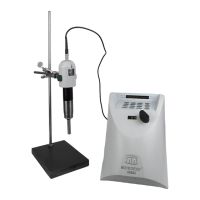Operation Manual Accessories
8-2
Cup Horn Operation
Cup Horns are high intensity ultrasonic water baths that allow samples to be processed in completely
closed containers (such as test tubes or vials). The ultrasonic probe never comes in contact with
sample so that sample loss, escape and/or cross contamination cannot occur. Large Cup Horns
allow for the simultaneous sonication of clusters of tube or vials providing for uniformity of
processing. Cup Horns are ideal for sterile or pathogenic sample processing. Three different sizes
are available.
Most laboratory grade plastic or borosilicate glass vessels that will fit into the cup are suitable for
sonication. Polystyrene and polycarbonate are the best transmitters of acoustic energy.
Polypropylene and polyethylene are too soft and may be ineffective. Glassware must be free of any
scratches and fully annealed or it may over stress and crack.
Ultrasonic energy is radiated directly upward through the base of the vessel while transmission
through the side is negligible. For this reason, flat-bottomed vessels are best and round bottomed
are next best. Vessels should have thin, uniform bases, without any heavy edges or centers. Conical
tubes should be tilted to expose maximum sample area to the horn. Samples should be wide and
shallow, rather than tall and narrow.
Maintain a small clearance around the vessel to allow adequate coolant flow. Suspend vessels at
least 3 to 6 mm above the face of the horn.
Energy transmission to the sample vessel can be determined easily by the pattern of sonication
(cavitation bubbles or micro streaming) in the coolant. At low levels, the bubbles will usually appear
as a dome of bubbles capping the coolant exit in the face of the horn. As the amplitude of the
ultrasonic vibration (amplitude control knob setting) is increased, the bubble pattern will lift and
become vertical diaphanous streams in the center of the cup, sometimes forming a spider-web effect.
Out Put Setting Parameters
When working with small samples there is a tendency to turn the Amplitude Control Knob
setting too high. Doing so causes the ultrasonic energy to go around the vessel, not through
it. The chart below is a good guide on selecting a power setting according to liquid sample
volume. However, all samples differ and may require a slightly higher power setting according
to their solid matter content and viscosity.
Sample Volume Power Setting
100µl - 500µl 0 - 1
500µl - 2 ml 1 - 2
2 ml - 5 ml 2 - 4
5 ml - 20 ml 4 - 5
20 ml - 50 ml 5 - 7
50 ml - 200 ml 7 - 8
Cup Horn Maintenance
The cup is made of acrylic plastic and should be cleaned periodically with a mild detergent,
not with abrasives or solvents. The horn is a tuned resonant body of titanium alloy. Do not
attempt to resurface the horn if it shows erosion after extended use. Contact Misonix if

